Business Finance Report
VerifiedAdded on 2020/01/28
|12
|3965
|78
Report
AI Summary
This report analyzes the traditional budgeting system used by BF Co., a manufacturing firm, and discusses its advantages and disadvantages. It also explores alternative budgeting methods such as zero-based budgeting, activity-based budgeting, and rolling budgets, highlighting their relevance in today's dynamic business environment. The report emphasizes the importance of effective budgeting for financial management and operational success.
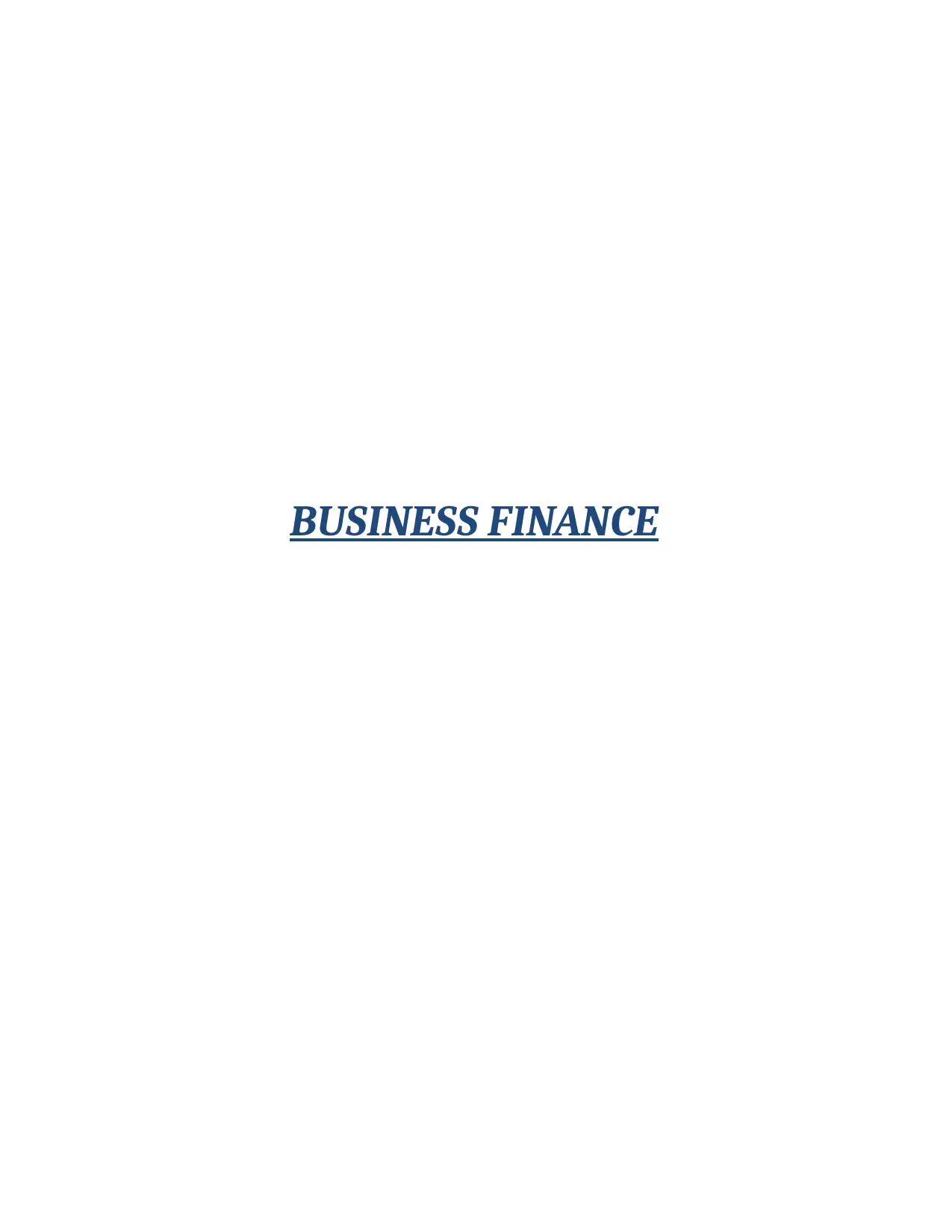
BUSINESS FINANCE
Paraphrase This Document
Need a fresh take? Get an instant paraphrase of this document with our AI Paraphraser
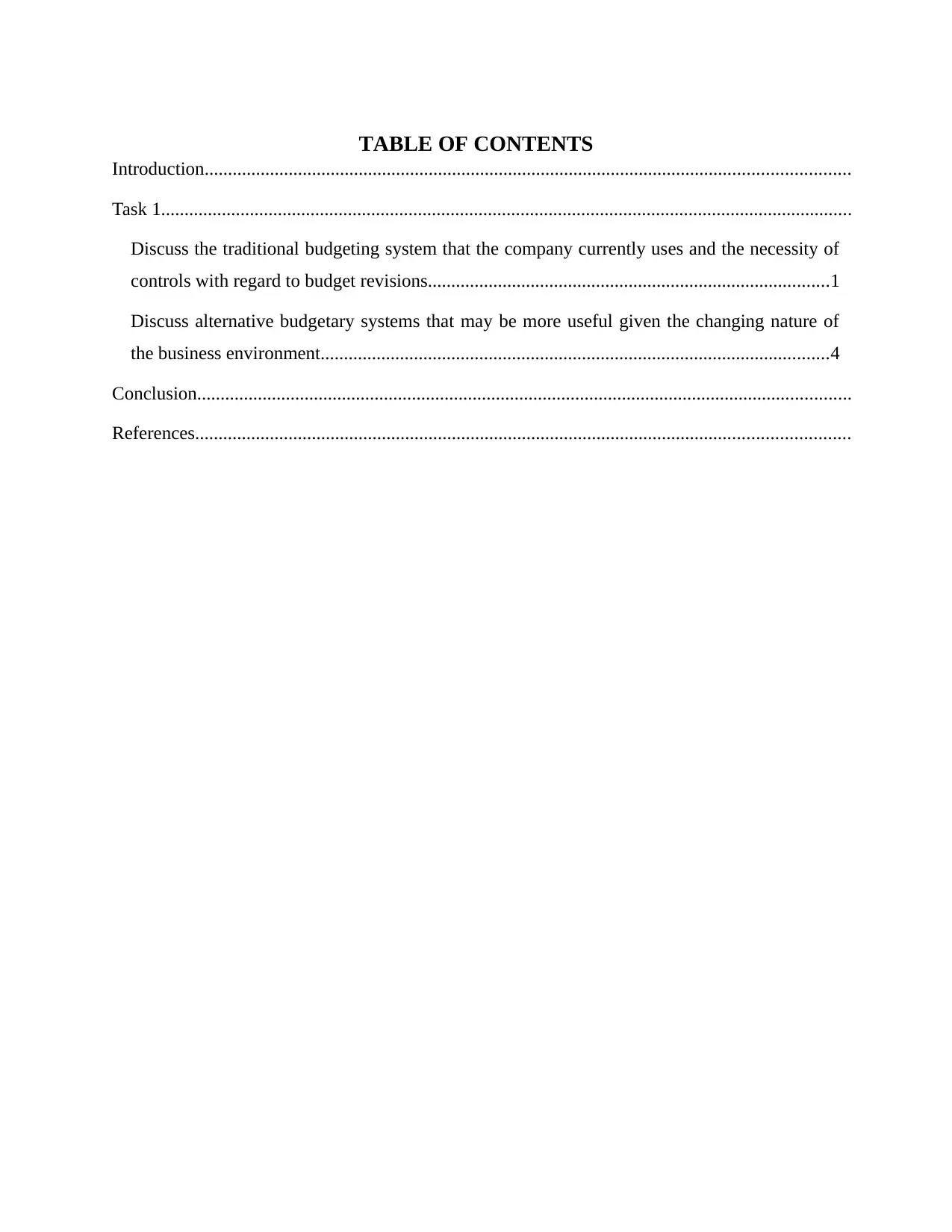
TABLE OF CONTENTS
Introduction..........................................................................................................................................
Task 1....................................................................................................................................................
Discuss the traditional budgeting system that the company currently uses and the necessity of
controls with regard to budget revisions......................................................................................1
Discuss alternative budgetary systems that may be more useful given the changing nature of
the business environment.............................................................................................................4
Conclusion............................................................................................................................................
References............................................................................................................................................
Introduction..........................................................................................................................................
Task 1....................................................................................................................................................
Discuss the traditional budgeting system that the company currently uses and the necessity of
controls with regard to budget revisions......................................................................................1
Discuss alternative budgetary systems that may be more useful given the changing nature of
the business environment.............................................................................................................4
Conclusion............................................................................................................................................
References............................................................................................................................................
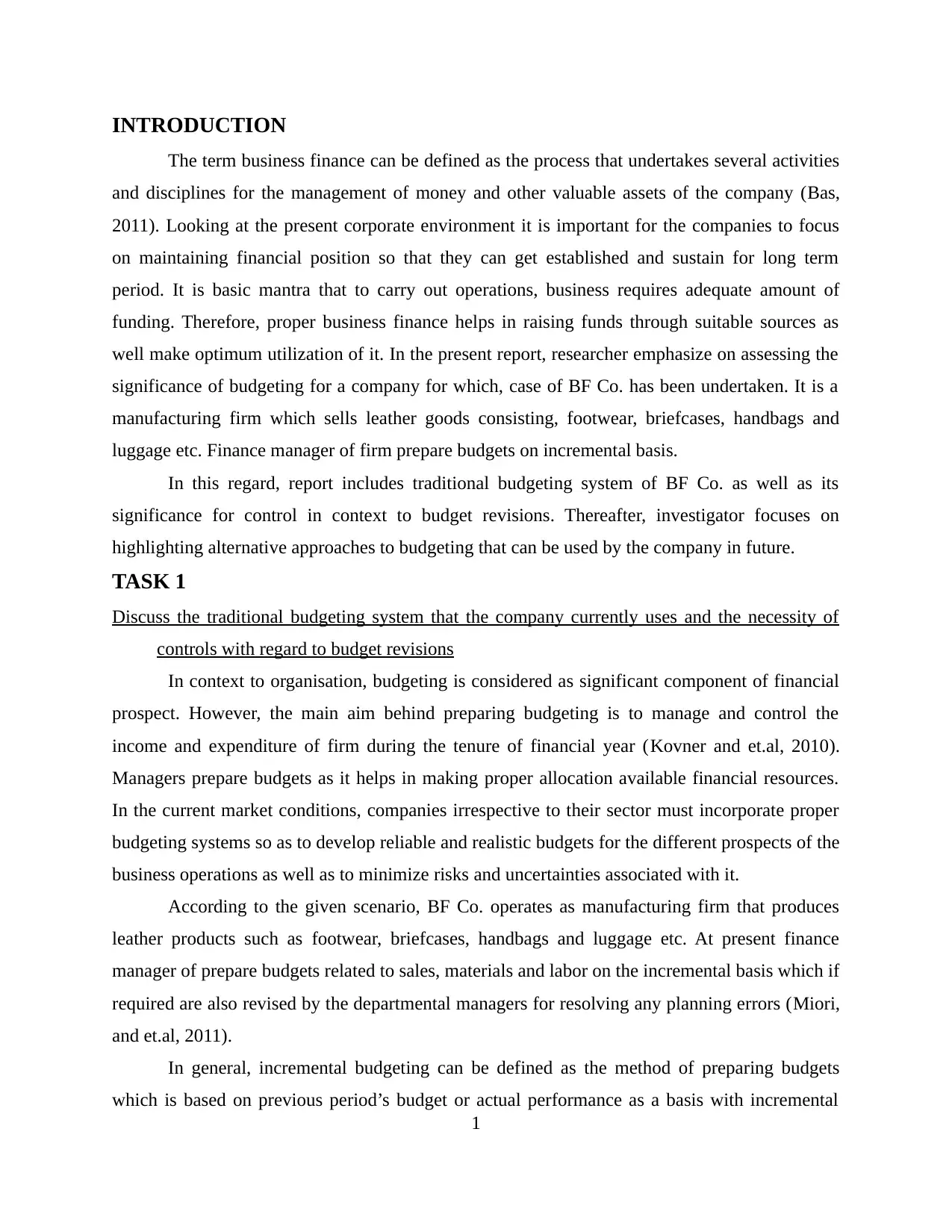
INTRODUCTION
The term business finance can be defined as the process that undertakes several activities
and disciplines for the management of money and other valuable assets of the company (Bas,
2011). Looking at the present corporate environment it is important for the companies to focus
on maintaining financial position so that they can get established and sustain for long term
period. It is basic mantra that to carry out operations, business requires adequate amount of
funding. Therefore, proper business finance helps in raising funds through suitable sources as
well make optimum utilization of it. In the present report, researcher emphasize on assessing the
significance of budgeting for a company for which, case of BF Co. has been undertaken. It is a
manufacturing firm which sells leather goods consisting, footwear, briefcases, handbags and
luggage etc. Finance manager of firm prepare budgets on incremental basis.
In this regard, report includes traditional budgeting system of BF Co. as well as its
significance for control in context to budget revisions. Thereafter, investigator focuses on
highlighting alternative approaches to budgeting that can be used by the company in future.
TASK 1
Discuss the traditional budgeting system that the company currently uses and the necessity of
controls with regard to budget revisions
In context to organisation, budgeting is considered as significant component of financial
prospect. However, the main aim behind preparing budgeting is to manage and control the
income and expenditure of firm during the tenure of financial year (Kovner and et.al, 2010).
Managers prepare budgets as it helps in making proper allocation available financial resources.
In the current market conditions, companies irrespective to their sector must incorporate proper
budgeting systems so as to develop reliable and realistic budgets for the different prospects of the
business operations as well as to minimize risks and uncertainties associated with it.
According to the given scenario, BF Co. operates as manufacturing firm that produces
leather products such as footwear, briefcases, handbags and luggage etc. At present finance
manager of prepare budgets related to sales, materials and labor on the incremental basis which if
required are also revised by the departmental managers for resolving any planning errors (Miori,
and et.al, 2011).
In general, incremental budgeting can be defined as the method of preparing budgets
which is based on previous period’s budget or actual performance as a basis with incremental
1
The term business finance can be defined as the process that undertakes several activities
and disciplines for the management of money and other valuable assets of the company (Bas,
2011). Looking at the present corporate environment it is important for the companies to focus
on maintaining financial position so that they can get established and sustain for long term
period. It is basic mantra that to carry out operations, business requires adequate amount of
funding. Therefore, proper business finance helps in raising funds through suitable sources as
well make optimum utilization of it. In the present report, researcher emphasize on assessing the
significance of budgeting for a company for which, case of BF Co. has been undertaken. It is a
manufacturing firm which sells leather goods consisting, footwear, briefcases, handbags and
luggage etc. Finance manager of firm prepare budgets on incremental basis.
In this regard, report includes traditional budgeting system of BF Co. as well as its
significance for control in context to budget revisions. Thereafter, investigator focuses on
highlighting alternative approaches to budgeting that can be used by the company in future.
TASK 1
Discuss the traditional budgeting system that the company currently uses and the necessity of
controls with regard to budget revisions
In context to organisation, budgeting is considered as significant component of financial
prospect. However, the main aim behind preparing budgeting is to manage and control the
income and expenditure of firm during the tenure of financial year (Kovner and et.al, 2010).
Managers prepare budgets as it helps in making proper allocation available financial resources.
In the current market conditions, companies irrespective to their sector must incorporate proper
budgeting systems so as to develop reliable and realistic budgets for the different prospects of the
business operations as well as to minimize risks and uncertainties associated with it.
According to the given scenario, BF Co. operates as manufacturing firm that produces
leather products such as footwear, briefcases, handbags and luggage etc. At present finance
manager of prepare budgets related to sales, materials and labor on the incremental basis which if
required are also revised by the departmental managers for resolving any planning errors (Miori,
and et.al, 2011).
In general, incremental budgeting can be defined as the method of preparing budgets
which is based on previous period’s budget or actual performance as a basis with incremental
1
⊘ This is a preview!⊘
Do you want full access?
Subscribe today to unlock all pages.

Trusted by 1+ million students worldwide
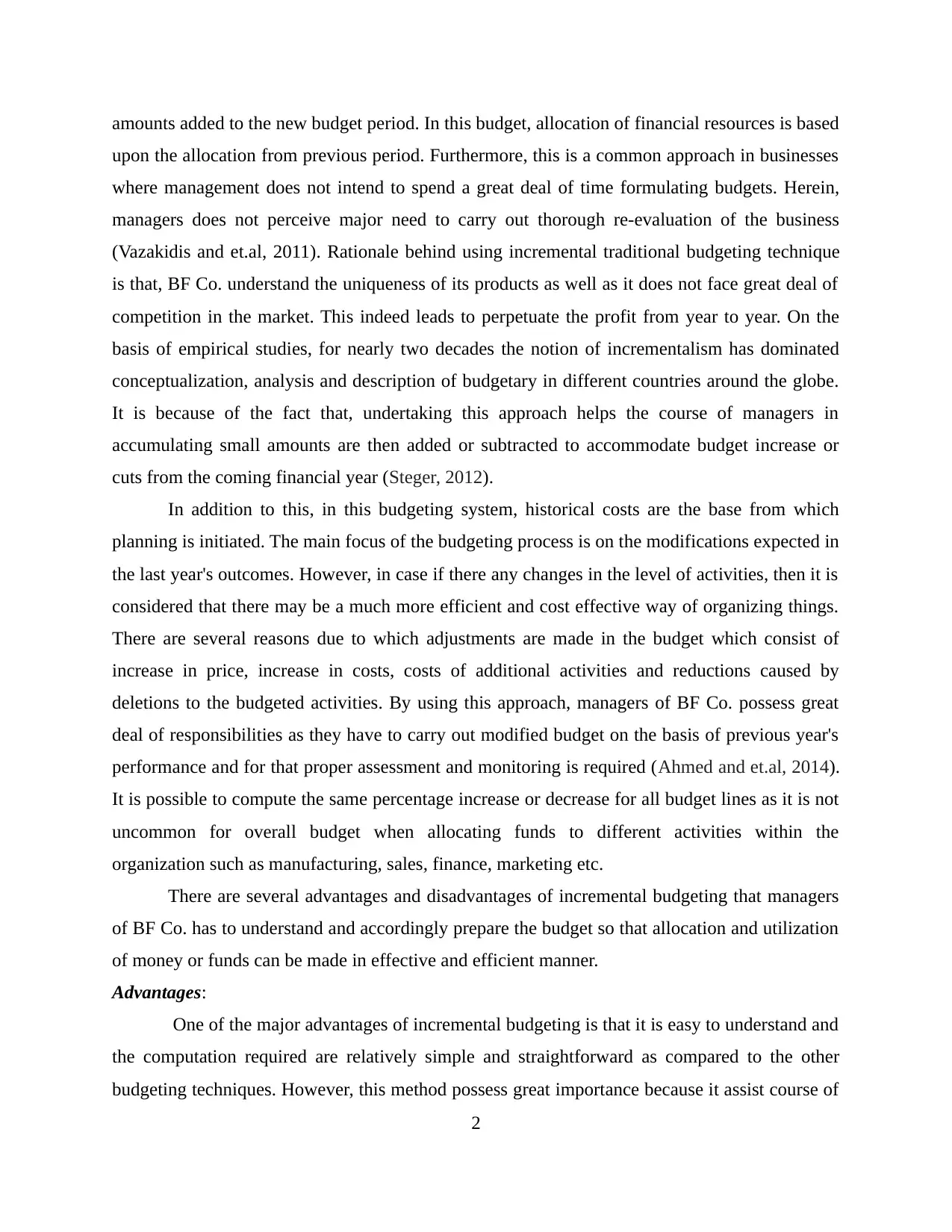
amounts added to the new budget period. In this budget, allocation of financial resources is based
upon the allocation from previous period. Furthermore, this is a common approach in businesses
where management does not intend to spend a great deal of time formulating budgets. Herein,
managers does not perceive major need to carry out thorough re-evaluation of the business
(Vazakidis and et.al, 2011). Rationale behind using incremental traditional budgeting technique
is that, BF Co. understand the uniqueness of its products as well as it does not face great deal of
competition in the market. This indeed leads to perpetuate the profit from year to year. On the
basis of empirical studies, for nearly two decades the notion of incrementalism has dominated
conceptualization, analysis and description of budgetary in different countries around the globe.
It is because of the fact that, undertaking this approach helps the course of managers in
accumulating small amounts are then added or subtracted to accommodate budget increase or
cuts from the coming financial year (Steger, 2012).
In addition to this, in this budgeting system, historical costs are the base from which
planning is initiated. The main focus of the budgeting process is on the modifications expected in
the last year's outcomes. However, in case if there any changes in the level of activities, then it is
considered that there may be a much more efficient and cost effective way of organizing things.
There are several reasons due to which adjustments are made in the budget which consist of
increase in price, increase in costs, costs of additional activities and reductions caused by
deletions to the budgeted activities. By using this approach, managers of BF Co. possess great
deal of responsibilities as they have to carry out modified budget on the basis of previous year's
performance and for that proper assessment and monitoring is required (Ahmed and et.al, 2014).
It is possible to compute the same percentage increase or decrease for all budget lines as it is not
uncommon for overall budget when allocating funds to different activities within the
organization such as manufacturing, sales, finance, marketing etc.
There are several advantages and disadvantages of incremental budgeting that managers
of BF Co. has to understand and accordingly prepare the budget so that allocation and utilization
of money or funds can be made in effective and efficient manner.
Advantages:
One of the major advantages of incremental budgeting is that it is easy to understand and
the computation required are relatively simple and straightforward as compared to the other
budgeting techniques. However, this method possess great importance because it assist course of
2
upon the allocation from previous period. Furthermore, this is a common approach in businesses
where management does not intend to spend a great deal of time formulating budgets. Herein,
managers does not perceive major need to carry out thorough re-evaluation of the business
(Vazakidis and et.al, 2011). Rationale behind using incremental traditional budgeting technique
is that, BF Co. understand the uniqueness of its products as well as it does not face great deal of
competition in the market. This indeed leads to perpetuate the profit from year to year. On the
basis of empirical studies, for nearly two decades the notion of incrementalism has dominated
conceptualization, analysis and description of budgetary in different countries around the globe.
It is because of the fact that, undertaking this approach helps the course of managers in
accumulating small amounts are then added or subtracted to accommodate budget increase or
cuts from the coming financial year (Steger, 2012).
In addition to this, in this budgeting system, historical costs are the base from which
planning is initiated. The main focus of the budgeting process is on the modifications expected in
the last year's outcomes. However, in case if there any changes in the level of activities, then it is
considered that there may be a much more efficient and cost effective way of organizing things.
There are several reasons due to which adjustments are made in the budget which consist of
increase in price, increase in costs, costs of additional activities and reductions caused by
deletions to the budgeted activities. By using this approach, managers of BF Co. possess great
deal of responsibilities as they have to carry out modified budget on the basis of previous year's
performance and for that proper assessment and monitoring is required (Ahmed and et.al, 2014).
It is possible to compute the same percentage increase or decrease for all budget lines as it is not
uncommon for overall budget when allocating funds to different activities within the
organization such as manufacturing, sales, finance, marketing etc.
There are several advantages and disadvantages of incremental budgeting that managers
of BF Co. has to understand and accordingly prepare the budget so that allocation and utilization
of money or funds can be made in effective and efficient manner.
Advantages:
One of the major advantages of incremental budgeting is that it is easy to understand and
the computation required are relatively simple and straightforward as compared to the other
budgeting techniques. However, this method possess great importance because it assist course of
2
Paraphrase This Document
Need a fresh take? Get an instant paraphrase of this document with our AI Paraphraser
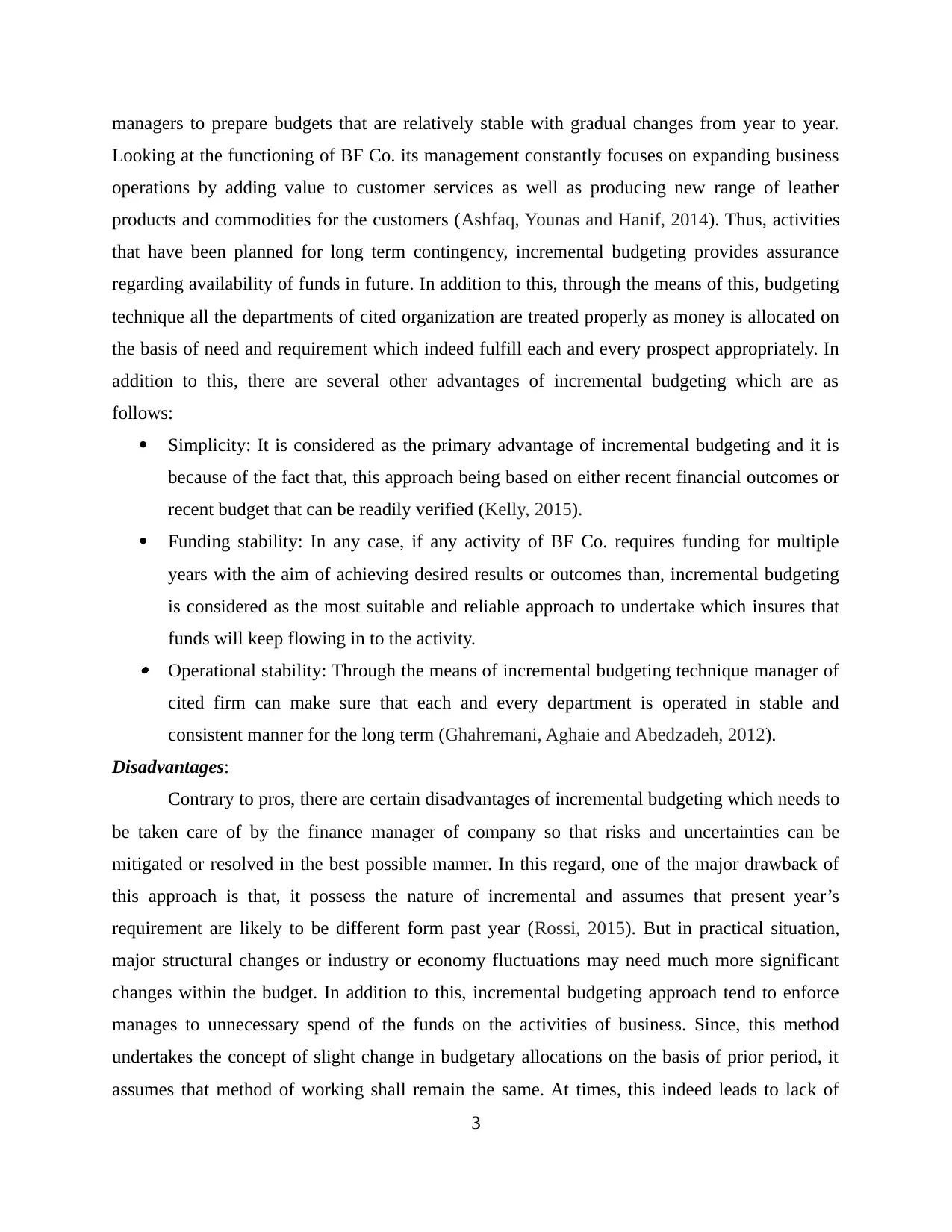
managers to prepare budgets that are relatively stable with gradual changes from year to year.
Looking at the functioning of BF Co. its management constantly focuses on expanding business
operations by adding value to customer services as well as producing new range of leather
products and commodities for the customers (Ashfaq, Younas and Hanif, 2014). Thus, activities
that have been planned for long term contingency, incremental budgeting provides assurance
regarding availability of funds in future. In addition to this, through the means of this, budgeting
technique all the departments of cited organization are treated properly as money is allocated on
the basis of need and requirement which indeed fulfill each and every prospect appropriately. In
addition to this, there are several other advantages of incremental budgeting which are as
follows:
Simplicity: It is considered as the primary advantage of incremental budgeting and it is
because of the fact that, this approach being based on either recent financial outcomes or
recent budget that can be readily verified (Kelly, 2015).
Funding stability: In any case, if any activity of BF Co. requires funding for multiple
years with the aim of achieving desired results or outcomes than, incremental budgeting
is considered as the most suitable and reliable approach to undertake which insures that
funds will keep flowing in to the activity. Operational stability: Through the means of incremental budgeting technique manager of
cited firm can make sure that each and every department is operated in stable and
consistent manner for the long term (Ghahremani, Aghaie and Abedzadeh, 2012).
Disadvantages:
Contrary to pros, there are certain disadvantages of incremental budgeting which needs to
be taken care of by the finance manager of company so that risks and uncertainties can be
mitigated or resolved in the best possible manner. In this regard, one of the major drawback of
this approach is that, it possess the nature of incremental and assumes that present year’s
requirement are likely to be different form past year (Rossi, 2015). But in practical situation,
major structural changes or industry or economy fluctuations may need much more significant
changes within the budget. In addition to this, incremental budgeting approach tend to enforce
manages to unnecessary spend of the funds on the activities of business. Since, this method
undertakes the concept of slight change in budgetary allocations on the basis of prior period, it
assumes that method of working shall remain the same. At times, this indeed leads to lack of
3
Looking at the functioning of BF Co. its management constantly focuses on expanding business
operations by adding value to customer services as well as producing new range of leather
products and commodities for the customers (Ashfaq, Younas and Hanif, 2014). Thus, activities
that have been planned for long term contingency, incremental budgeting provides assurance
regarding availability of funds in future. In addition to this, through the means of this, budgeting
technique all the departments of cited organization are treated properly as money is allocated on
the basis of need and requirement which indeed fulfill each and every prospect appropriately. In
addition to this, there are several other advantages of incremental budgeting which are as
follows:
Simplicity: It is considered as the primary advantage of incremental budgeting and it is
because of the fact that, this approach being based on either recent financial outcomes or
recent budget that can be readily verified (Kelly, 2015).
Funding stability: In any case, if any activity of BF Co. requires funding for multiple
years with the aim of achieving desired results or outcomes than, incremental budgeting
is considered as the most suitable and reliable approach to undertake which insures that
funds will keep flowing in to the activity. Operational stability: Through the means of incremental budgeting technique manager of
cited firm can make sure that each and every department is operated in stable and
consistent manner for the long term (Ghahremani, Aghaie and Abedzadeh, 2012).
Disadvantages:
Contrary to pros, there are certain disadvantages of incremental budgeting which needs to
be taken care of by the finance manager of company so that risks and uncertainties can be
mitigated or resolved in the best possible manner. In this regard, one of the major drawback of
this approach is that, it possess the nature of incremental and assumes that present year’s
requirement are likely to be different form past year (Rossi, 2015). But in practical situation,
major structural changes or industry or economy fluctuations may need much more significant
changes within the budget. In addition to this, incremental budgeting approach tend to enforce
manages to unnecessary spend of the funds on the activities of business. Since, this method
undertakes the concept of slight change in budgetary allocations on the basis of prior period, it
assumes that method of working shall remain the same. At times, this indeed leads to lack of
3
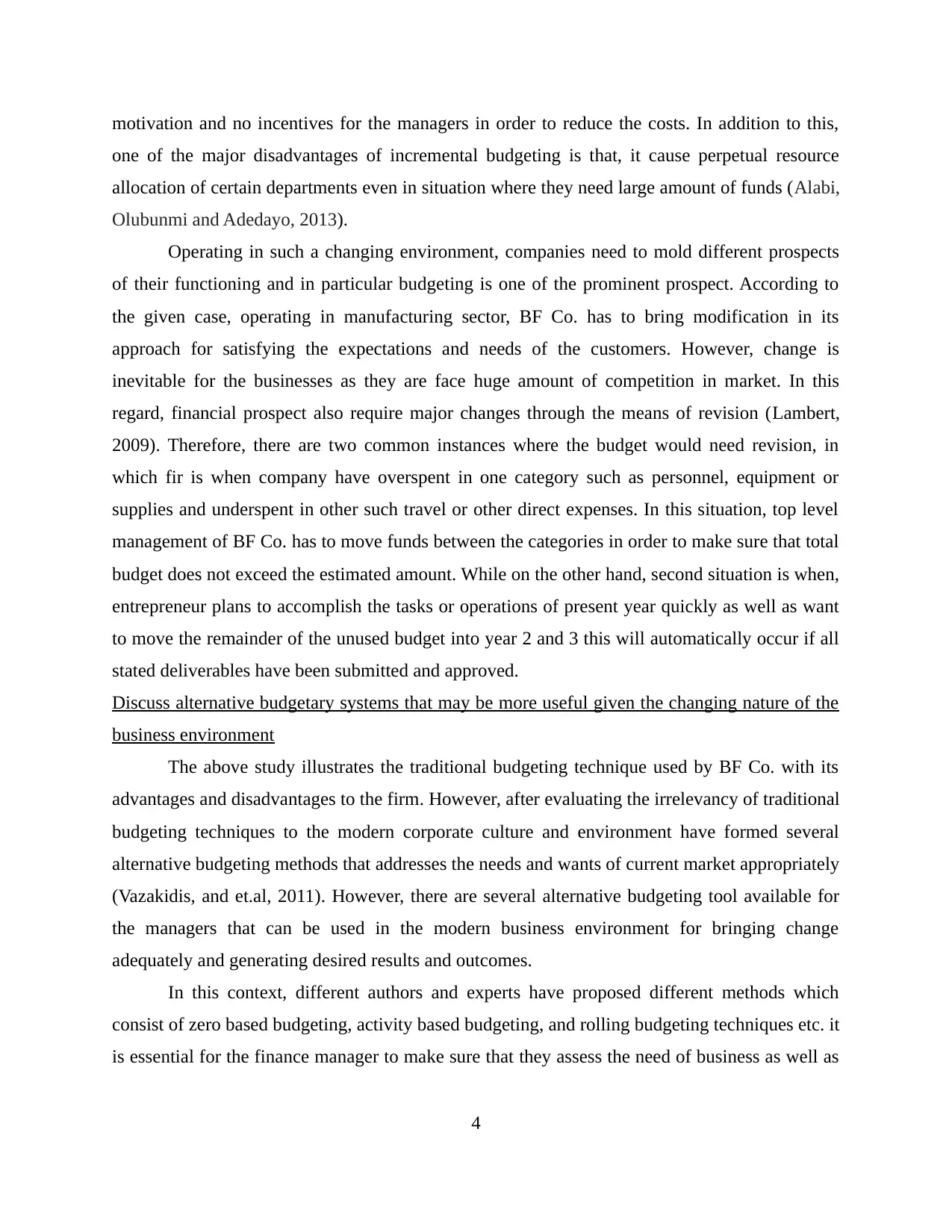
motivation and no incentives for the managers in order to reduce the costs. In addition to this,
one of the major disadvantages of incremental budgeting is that, it cause perpetual resource
allocation of certain departments even in situation where they need large amount of funds (Alabi,
Olubunmi and Adedayo, 2013).
Operating in such a changing environment, companies need to mold different prospects
of their functioning and in particular budgeting is one of the prominent prospect. According to
the given case, operating in manufacturing sector, BF Co. has to bring modification in its
approach for satisfying the expectations and needs of the customers. However, change is
inevitable for the businesses as they are face huge amount of competition in market. In this
regard, financial prospect also require major changes through the means of revision (Lambert,
2009). Therefore, there are two common instances where the budget would need revision, in
which fir is when company have overspent in one category such as personnel, equipment or
supplies and underspent in other such travel or other direct expenses. In this situation, top level
management of BF Co. has to move funds between the categories in order to make sure that total
budget does not exceed the estimated amount. While on the other hand, second situation is when,
entrepreneur plans to accomplish the tasks or operations of present year quickly as well as want
to move the remainder of the unused budget into year 2 and 3 this will automatically occur if all
stated deliverables have been submitted and approved.
Discuss alternative budgetary systems that may be more useful given the changing nature of the
business environment
The above study illustrates the traditional budgeting technique used by BF Co. with its
advantages and disadvantages to the firm. However, after evaluating the irrelevancy of traditional
budgeting techniques to the modern corporate culture and environment have formed several
alternative budgeting methods that addresses the needs and wants of current market appropriately
(Vazakidis, and et.al, 2011). However, there are several alternative budgeting tool available for
the managers that can be used in the modern business environment for bringing change
adequately and generating desired results and outcomes.
In this context, different authors and experts have proposed different methods which
consist of zero based budgeting, activity based budgeting, and rolling budgeting techniques etc. it
is essential for the finance manager to make sure that they assess the need of business as well as
4
one of the major disadvantages of incremental budgeting is that, it cause perpetual resource
allocation of certain departments even in situation where they need large amount of funds (Alabi,
Olubunmi and Adedayo, 2013).
Operating in such a changing environment, companies need to mold different prospects
of their functioning and in particular budgeting is one of the prominent prospect. According to
the given case, operating in manufacturing sector, BF Co. has to bring modification in its
approach for satisfying the expectations and needs of the customers. However, change is
inevitable for the businesses as they are face huge amount of competition in market. In this
regard, financial prospect also require major changes through the means of revision (Lambert,
2009). Therefore, there are two common instances where the budget would need revision, in
which fir is when company have overspent in one category such as personnel, equipment or
supplies and underspent in other such travel or other direct expenses. In this situation, top level
management of BF Co. has to move funds between the categories in order to make sure that total
budget does not exceed the estimated amount. While on the other hand, second situation is when,
entrepreneur plans to accomplish the tasks or operations of present year quickly as well as want
to move the remainder of the unused budget into year 2 and 3 this will automatically occur if all
stated deliverables have been submitted and approved.
Discuss alternative budgetary systems that may be more useful given the changing nature of the
business environment
The above study illustrates the traditional budgeting technique used by BF Co. with its
advantages and disadvantages to the firm. However, after evaluating the irrelevancy of traditional
budgeting techniques to the modern corporate culture and environment have formed several
alternative budgeting methods that addresses the needs and wants of current market appropriately
(Vazakidis, and et.al, 2011). However, there are several alternative budgeting tool available for
the managers that can be used in the modern business environment for bringing change
adequately and generating desired results and outcomes.
In this context, different authors and experts have proposed different methods which
consist of zero based budgeting, activity based budgeting, and rolling budgeting techniques etc. it
is essential for the finance manager to make sure that they assess the need of business as well as
4
⊘ This is a preview!⊘
Do you want full access?
Subscribe today to unlock all pages.

Trusted by 1+ million students worldwide

consider its surroundings and accordingly select the best suitable budgeting technique for
managing funds and expenditure effectively.
Zero based budgeting:
In general, zero based budgeting can be defined as the process that initiates from zero as
in this, carry forward figure of past year is not taken in consideration. Under this, headings of
budget starts with zero or no balance. However, before using this budgeting technique managers
have the duty of assessing the function of each department comprehensively so that all the
expenditure requirement can be evaluated (Ashfaq, Younas and Hanif, 2014). The main aim of
zero based budgeting is to achieve optimal allocation of resource to different departments of
entity where they are needed the most. Furthermore, it helps the course of managers to allocate
and use the available resources effectively for the achievement of desired results and outcomes.
Furthermore, zero based budgeting consist of varied states which are as follows:
Under this method, managers have the duty of identifying the activities where the fund is
required the mots so that smart decisions can be made regarding the allocation of financial
resources appropriately for the improvement of activities in future contingency. However, these
stages consist of:
Costs analysis of each activity
Defining the purpose of activity
Alternative ways to achieve the goal (Bas, 2011)
Establishing performance measures for the activities
Assessing the consequences of not achieving the targets
Along with this, zero based budgeting requires each cost element to be justified
specifically before considered into budgets. However, the suitability of this budget holds key in
allocation of resources in the areas which generate optimal outcomes for the firm. It is not
important that, every firm require research and development, advertising and training therefore,
zero based budgeting tool assist in making proper apportionment of financial resources to the
significant areas rather than emphasizing on the non-significant departments (Zero Based
Budgeting Kaplan Financial Limited, 2012). In addition to this, zero based budgeting supports
the top level management in determining strategic goals as well as implementing budgeting
process to enhance the functioning of different departments of the business. Further, through the
5
managing funds and expenditure effectively.
Zero based budgeting:
In general, zero based budgeting can be defined as the process that initiates from zero as
in this, carry forward figure of past year is not taken in consideration. Under this, headings of
budget starts with zero or no balance. However, before using this budgeting technique managers
have the duty of assessing the function of each department comprehensively so that all the
expenditure requirement can be evaluated (Ashfaq, Younas and Hanif, 2014). The main aim of
zero based budgeting is to achieve optimal allocation of resource to different departments of
entity where they are needed the most. Furthermore, it helps the course of managers to allocate
and use the available resources effectively for the achievement of desired results and outcomes.
Furthermore, zero based budgeting consist of varied states which are as follows:
Under this method, managers have the duty of identifying the activities where the fund is
required the mots so that smart decisions can be made regarding the allocation of financial
resources appropriately for the improvement of activities in future contingency. However, these
stages consist of:
Costs analysis of each activity
Defining the purpose of activity
Alternative ways to achieve the goal (Bas, 2011)
Establishing performance measures for the activities
Assessing the consequences of not achieving the targets
Along with this, zero based budgeting requires each cost element to be justified
specifically before considered into budgets. However, the suitability of this budget holds key in
allocation of resources in the areas which generate optimal outcomes for the firm. It is not
important that, every firm require research and development, advertising and training therefore,
zero based budgeting tool assist in making proper apportionment of financial resources to the
significant areas rather than emphasizing on the non-significant departments (Zero Based
Budgeting Kaplan Financial Limited, 2012). In addition to this, zero based budgeting supports
the top level management in determining strategic goals as well as implementing budgeting
process to enhance the functioning of different departments of the business. Further, through the
5
Paraphrase This Document
Need a fresh take? Get an instant paraphrase of this document with our AI Paraphraser
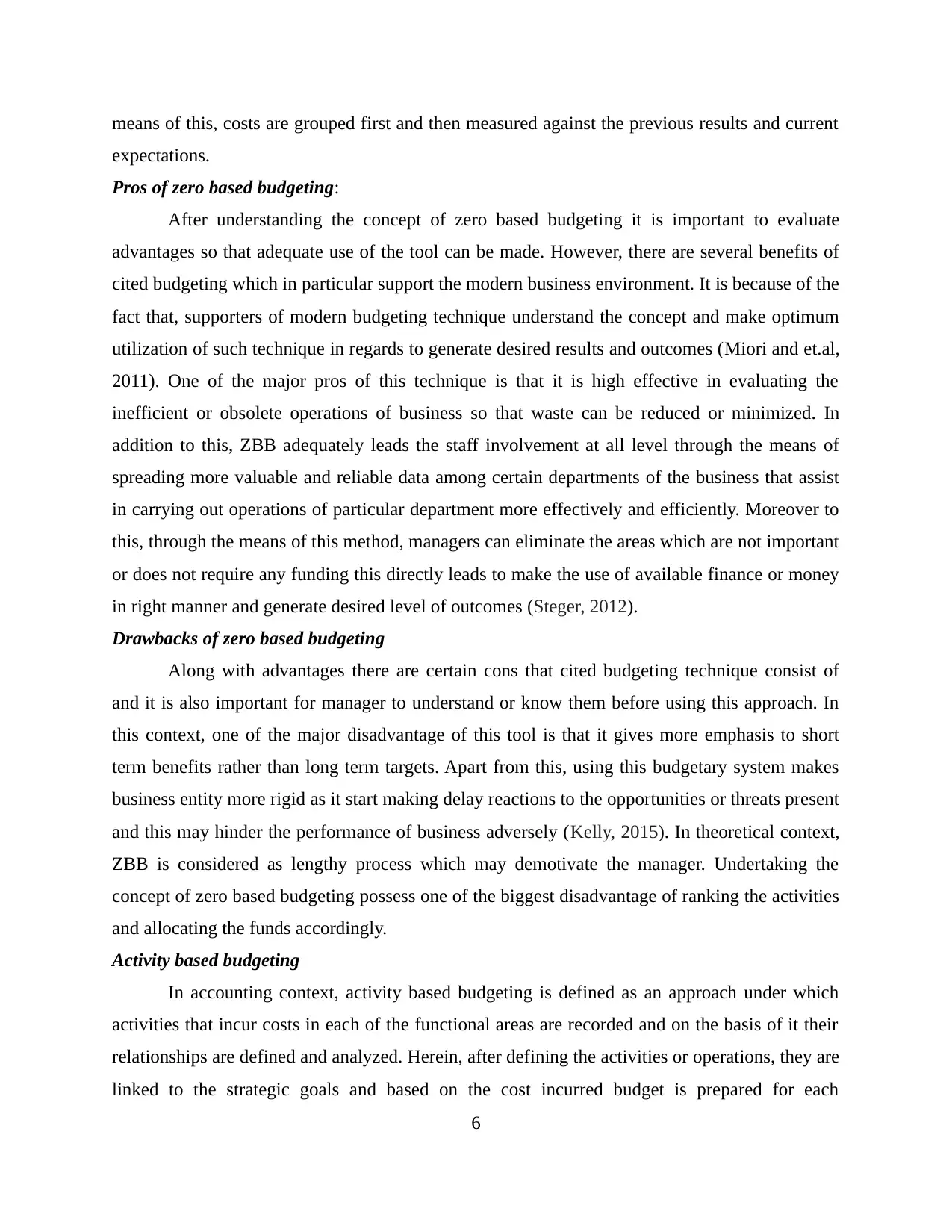
means of this, costs are grouped first and then measured against the previous results and current
expectations.
Pros of zero based budgeting:
After understanding the concept of zero based budgeting it is important to evaluate
advantages so that adequate use of the tool can be made. However, there are several benefits of
cited budgeting which in particular support the modern business environment. It is because of the
fact that, supporters of modern budgeting technique understand the concept and make optimum
utilization of such technique in regards to generate desired results and outcomes (Miori and et.al,
2011). One of the major pros of this technique is that it is high effective in evaluating the
inefficient or obsolete operations of business so that waste can be reduced or minimized. In
addition to this, ZBB adequately leads the staff involvement at all level through the means of
spreading more valuable and reliable data among certain departments of the business that assist
in carrying out operations of particular department more effectively and efficiently. Moreover to
this, through the means of this method, managers can eliminate the areas which are not important
or does not require any funding this directly leads to make the use of available finance or money
in right manner and generate desired level of outcomes (Steger, 2012).
Drawbacks of zero based budgeting
Along with advantages there are certain cons that cited budgeting technique consist of
and it is also important for manager to understand or know them before using this approach. In
this context, one of the major disadvantage of this tool is that it gives more emphasis to short
term benefits rather than long term targets. Apart from this, using this budgetary system makes
business entity more rigid as it start making delay reactions to the opportunities or threats present
and this may hinder the performance of business adversely (Kelly, 2015). In theoretical context,
ZBB is considered as lengthy process which may demotivate the manager. Undertaking the
concept of zero based budgeting possess one of the biggest disadvantage of ranking the activities
and allocating the funds accordingly.
Activity based budgeting
In accounting context, activity based budgeting is defined as an approach under which
activities that incur costs in each of the functional areas are recorded and on the basis of it their
relationships are defined and analyzed. Herein, after defining the activities or operations, they are
linked to the strategic goals and based on the cost incurred budget is prepared for each
6
expectations.
Pros of zero based budgeting:
After understanding the concept of zero based budgeting it is important to evaluate
advantages so that adequate use of the tool can be made. However, there are several benefits of
cited budgeting which in particular support the modern business environment. It is because of the
fact that, supporters of modern budgeting technique understand the concept and make optimum
utilization of such technique in regards to generate desired results and outcomes (Miori and et.al,
2011). One of the major pros of this technique is that it is high effective in evaluating the
inefficient or obsolete operations of business so that waste can be reduced or minimized. In
addition to this, ZBB adequately leads the staff involvement at all level through the means of
spreading more valuable and reliable data among certain departments of the business that assist
in carrying out operations of particular department more effectively and efficiently. Moreover to
this, through the means of this method, managers can eliminate the areas which are not important
or does not require any funding this directly leads to make the use of available finance or money
in right manner and generate desired level of outcomes (Steger, 2012).
Drawbacks of zero based budgeting
Along with advantages there are certain cons that cited budgeting technique consist of
and it is also important for manager to understand or know them before using this approach. In
this context, one of the major disadvantage of this tool is that it gives more emphasis to short
term benefits rather than long term targets. Apart from this, using this budgetary system makes
business entity more rigid as it start making delay reactions to the opportunities or threats present
and this may hinder the performance of business adversely (Kelly, 2015). In theoretical context,
ZBB is considered as lengthy process which may demotivate the manager. Undertaking the
concept of zero based budgeting possess one of the biggest disadvantage of ranking the activities
and allocating the funds accordingly.
Activity based budgeting
In accounting context, activity based budgeting is defined as an approach under which
activities that incur costs in each of the functional areas are recorded and on the basis of it their
relationships are defined and analyzed. Herein, after defining the activities or operations, they are
linked to the strategic goals and based on the cost incurred budget is prepared for each
6
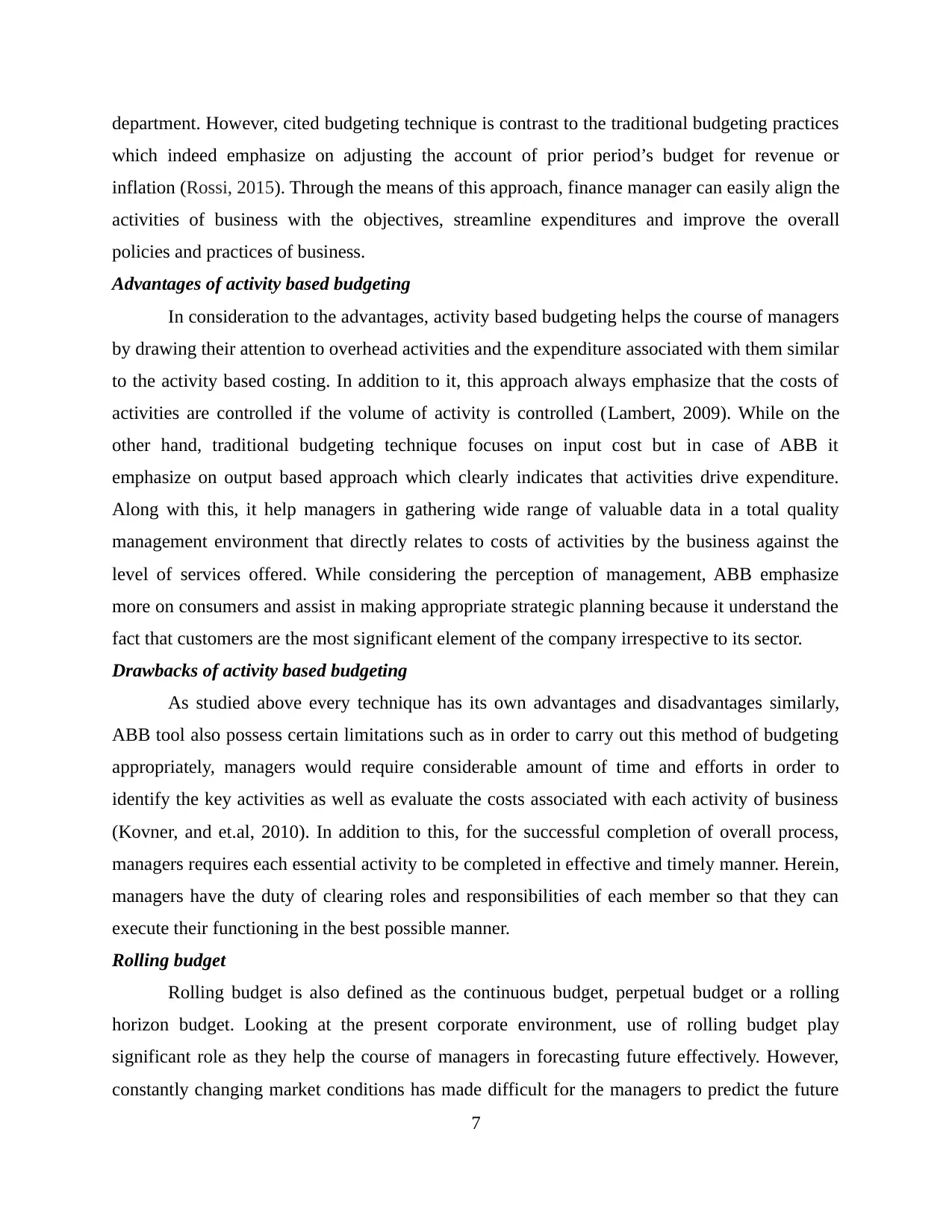
department. However, cited budgeting technique is contrast to the traditional budgeting practices
which indeed emphasize on adjusting the account of prior period’s budget for revenue or
inflation (Rossi, 2015). Through the means of this approach, finance manager can easily align the
activities of business with the objectives, streamline expenditures and improve the overall
policies and practices of business.
Advantages of activity based budgeting
In consideration to the advantages, activity based budgeting helps the course of managers
by drawing their attention to overhead activities and the expenditure associated with them similar
to the activity based costing. In addition to it, this approach always emphasize that the costs of
activities are controlled if the volume of activity is controlled (Lambert, 2009). While on the
other hand, traditional budgeting technique focuses on input cost but in case of ABB it
emphasize on output based approach which clearly indicates that activities drive expenditure.
Along with this, it help managers in gathering wide range of valuable data in a total quality
management environment that directly relates to costs of activities by the business against the
level of services offered. While considering the perception of management, ABB emphasize
more on consumers and assist in making appropriate strategic planning because it understand the
fact that customers are the most significant element of the company irrespective to its sector.
Drawbacks of activity based budgeting
As studied above every technique has its own advantages and disadvantages similarly,
ABB tool also possess certain limitations such as in order to carry out this method of budgeting
appropriately, managers would require considerable amount of time and efforts in order to
identify the key activities as well as evaluate the costs associated with each activity of business
(Kovner, and et.al, 2010). In addition to this, for the successful completion of overall process,
managers requires each essential activity to be completed in effective and timely manner. Herein,
managers have the duty of clearing roles and responsibilities of each member so that they can
execute their functioning in the best possible manner.
Rolling budget
Rolling budget is also defined as the continuous budget, perpetual budget or a rolling
horizon budget. Looking at the present corporate environment, use of rolling budget play
significant role as they help the course of managers in forecasting future effectively. However,
constantly changing market conditions has made difficult for the managers to predict the future
7
which indeed emphasize on adjusting the account of prior period’s budget for revenue or
inflation (Rossi, 2015). Through the means of this approach, finance manager can easily align the
activities of business with the objectives, streamline expenditures and improve the overall
policies and practices of business.
Advantages of activity based budgeting
In consideration to the advantages, activity based budgeting helps the course of managers
by drawing their attention to overhead activities and the expenditure associated with them similar
to the activity based costing. In addition to it, this approach always emphasize that the costs of
activities are controlled if the volume of activity is controlled (Lambert, 2009). While on the
other hand, traditional budgeting technique focuses on input cost but in case of ABB it
emphasize on output based approach which clearly indicates that activities drive expenditure.
Along with this, it help managers in gathering wide range of valuable data in a total quality
management environment that directly relates to costs of activities by the business against the
level of services offered. While considering the perception of management, ABB emphasize
more on consumers and assist in making appropriate strategic planning because it understand the
fact that customers are the most significant element of the company irrespective to its sector.
Drawbacks of activity based budgeting
As studied above every technique has its own advantages and disadvantages similarly,
ABB tool also possess certain limitations such as in order to carry out this method of budgeting
appropriately, managers would require considerable amount of time and efforts in order to
identify the key activities as well as evaluate the costs associated with each activity of business
(Kovner, and et.al, 2010). In addition to this, for the successful completion of overall process,
managers requires each essential activity to be completed in effective and timely manner. Herein,
managers have the duty of clearing roles and responsibilities of each member so that they can
execute their functioning in the best possible manner.
Rolling budget
Rolling budget is also defined as the continuous budget, perpetual budget or a rolling
horizon budget. Looking at the present corporate environment, use of rolling budget play
significant role as they help the course of managers in forecasting future effectively. However,
constantly changing market conditions has made difficult for the managers to predict the future
7
⊘ This is a preview!⊘
Do you want full access?
Subscribe today to unlock all pages.

Trusted by 1+ million students worldwide
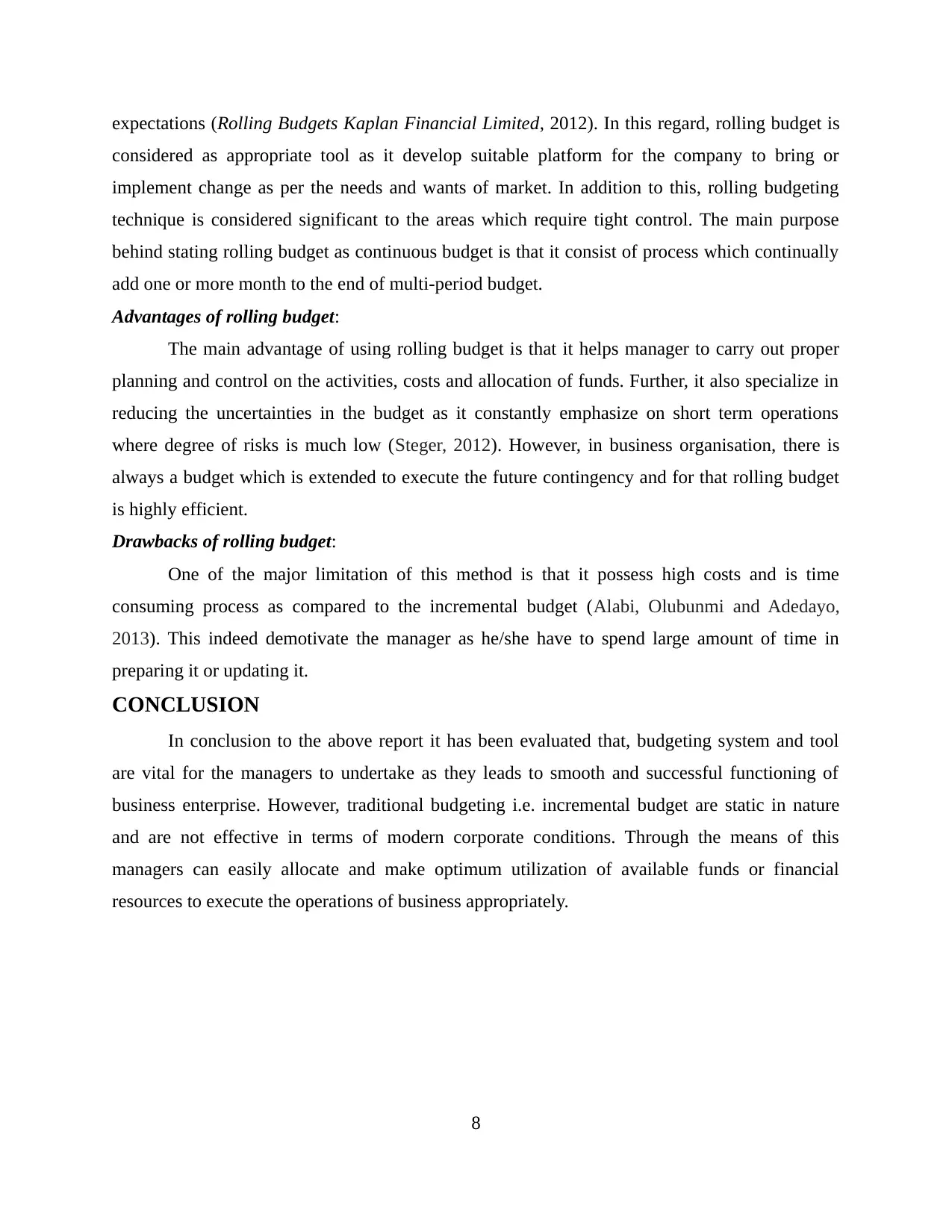
expectations (Rolling Budgets Kaplan Financial Limited, 2012). In this regard, rolling budget is
considered as appropriate tool as it develop suitable platform for the company to bring or
implement change as per the needs and wants of market. In addition to this, rolling budgeting
technique is considered significant to the areas which require tight control. The main purpose
behind stating rolling budget as continuous budget is that it consist of process which continually
add one or more month to the end of multi-period budget.
Advantages of rolling budget:
The main advantage of using rolling budget is that it helps manager to carry out proper
planning and control on the activities, costs and allocation of funds. Further, it also specialize in
reducing the uncertainties in the budget as it constantly emphasize on short term operations
where degree of risks is much low (Steger, 2012). However, in business organisation, there is
always a budget which is extended to execute the future contingency and for that rolling budget
is highly efficient.
Drawbacks of rolling budget:
One of the major limitation of this method is that it possess high costs and is time
consuming process as compared to the incremental budget (Alabi, Olubunmi and Adedayo,
2013). This indeed demotivate the manager as he/she have to spend large amount of time in
preparing it or updating it.
CONCLUSION
In conclusion to the above report it has been evaluated that, budgeting system and tool
are vital for the managers to undertake as they leads to smooth and successful functioning of
business enterprise. However, traditional budgeting i.e. incremental budget are static in nature
and are not effective in terms of modern corporate conditions. Through the means of this
managers can easily allocate and make optimum utilization of available funds or financial
resources to execute the operations of business appropriately.
8
considered as appropriate tool as it develop suitable platform for the company to bring or
implement change as per the needs and wants of market. In addition to this, rolling budgeting
technique is considered significant to the areas which require tight control. The main purpose
behind stating rolling budget as continuous budget is that it consist of process which continually
add one or more month to the end of multi-period budget.
Advantages of rolling budget:
The main advantage of using rolling budget is that it helps manager to carry out proper
planning and control on the activities, costs and allocation of funds. Further, it also specialize in
reducing the uncertainties in the budget as it constantly emphasize on short term operations
where degree of risks is much low (Steger, 2012). However, in business organisation, there is
always a budget which is extended to execute the future contingency and for that rolling budget
is highly efficient.
Drawbacks of rolling budget:
One of the major limitation of this method is that it possess high costs and is time
consuming process as compared to the incremental budget (Alabi, Olubunmi and Adedayo,
2013). This indeed demotivate the manager as he/she have to spend large amount of time in
preparing it or updating it.
CONCLUSION
In conclusion to the above report it has been evaluated that, budgeting system and tool
are vital for the managers to undertake as they leads to smooth and successful functioning of
business enterprise. However, traditional budgeting i.e. incremental budget are static in nature
and are not effective in terms of modern corporate conditions. Through the means of this
managers can easily allocate and make optimum utilization of available funds or financial
resources to execute the operations of business appropriately.
8
Paraphrase This Document
Need a fresh take? Get an instant paraphrase of this document with our AI Paraphraser
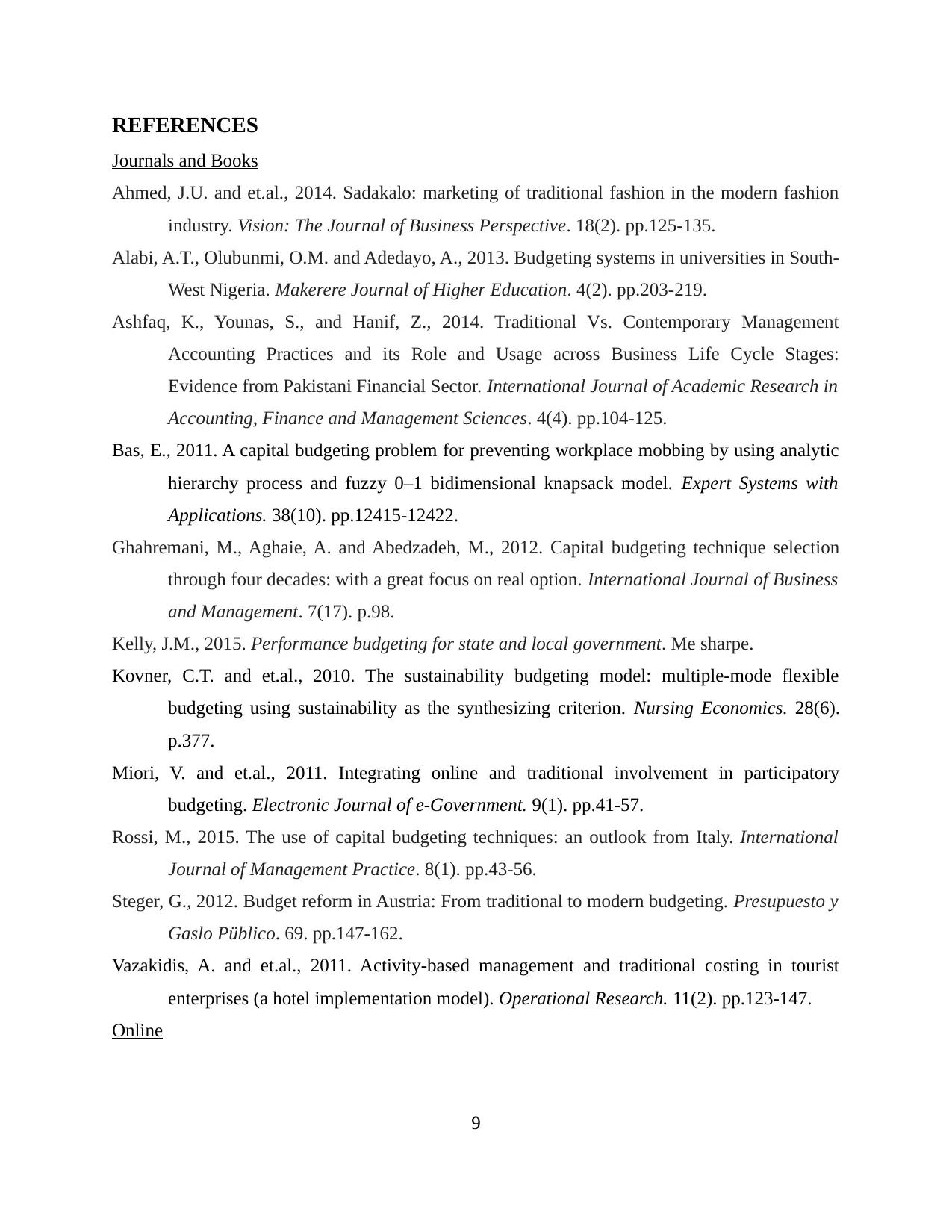
REFERENCES
Journals and Books
Ahmed, J.U. and et.al., 2014. Sadakalo: marketing of traditional fashion in the modern fashion
industry. Vision: The Journal of Business Perspective. 18(2). pp.125-135.
Alabi, A.T., Olubunmi, O.M. and Adedayo, A., 2013. Budgeting systems in universities in South-
West Nigeria. Makerere Journal of Higher Education. 4(2). pp.203-219.
Ashfaq, K., Younas, S., and Hanif, Z., 2014. Traditional Vs. Contemporary Management
Accounting Practices and its Role and Usage across Business Life Cycle Stages:
Evidence from Pakistani Financial Sector. International Journal of Academic Research in
Accounting, Finance and Management Sciences. 4(4). pp.104-125.
Bas, E., 2011. A capital budgeting problem for preventing workplace mobbing by using analytic
hierarchy process and fuzzy 0–1 bidimensional knapsack model. Expert Systems with
Applications. 38(10). pp.12415-12422.
Ghahremani, M., Aghaie, A. and Abedzadeh, M., 2012. Capital budgeting technique selection
through four decades: with a great focus on real option. International Journal of Business
and Management. 7(17). p.98.
Kelly, J.M., 2015. Performance budgeting for state and local government. Me sharpe.
Kovner, C.T. and et.al., 2010. The sustainability budgeting model: multiple-mode flexible
budgeting using sustainability as the synthesizing criterion. Nursing Economics. 28(6).
p.377.
Miori, V. and et.al., 2011. Integrating online and traditional involvement in participatory
budgeting. Electronic Journal of e-Government. 9(1). pp.41-57.
Rossi, M., 2015. The use of capital budgeting techniques: an outlook from Italy. International
Journal of Management Practice. 8(1). pp.43-56.
Steger, G., 2012. Budget reform in Austria: From traditional to modern budgeting. Presupuesto y
Gaslo Püblico. 69. pp.147-162.
Vazakidis, A. and et.al., 2011. Activity-based management and traditional costing in tourist
enterprises (a hotel implementation model). Operational Research. 11(2). pp.123-147.
Online
9
Journals and Books
Ahmed, J.U. and et.al., 2014. Sadakalo: marketing of traditional fashion in the modern fashion
industry. Vision: The Journal of Business Perspective. 18(2). pp.125-135.
Alabi, A.T., Olubunmi, O.M. and Adedayo, A., 2013. Budgeting systems in universities in South-
West Nigeria. Makerere Journal of Higher Education. 4(2). pp.203-219.
Ashfaq, K., Younas, S., and Hanif, Z., 2014. Traditional Vs. Contemporary Management
Accounting Practices and its Role and Usage across Business Life Cycle Stages:
Evidence from Pakistani Financial Sector. International Journal of Academic Research in
Accounting, Finance and Management Sciences. 4(4). pp.104-125.
Bas, E., 2011. A capital budgeting problem for preventing workplace mobbing by using analytic
hierarchy process and fuzzy 0–1 bidimensional knapsack model. Expert Systems with
Applications. 38(10). pp.12415-12422.
Ghahremani, M., Aghaie, A. and Abedzadeh, M., 2012. Capital budgeting technique selection
through four decades: with a great focus on real option. International Journal of Business
and Management. 7(17). p.98.
Kelly, J.M., 2015. Performance budgeting for state and local government. Me sharpe.
Kovner, C.T. and et.al., 2010. The sustainability budgeting model: multiple-mode flexible
budgeting using sustainability as the synthesizing criterion. Nursing Economics. 28(6).
p.377.
Miori, V. and et.al., 2011. Integrating online and traditional involvement in participatory
budgeting. Electronic Journal of e-Government. 9(1). pp.41-57.
Rossi, M., 2015. The use of capital budgeting techniques: an outlook from Italy. International
Journal of Management Practice. 8(1). pp.43-56.
Steger, G., 2012. Budget reform in Austria: From traditional to modern budgeting. Presupuesto y
Gaslo Püblico. 69. pp.147-162.
Vazakidis, A. and et.al., 2011. Activity-based management and traditional costing in tourist
enterprises (a hotel implementation model). Operational Research. 11(2). pp.123-147.
Online
9

Lambert, M., 2009. Five Purposes of Budgeting. [Online]. Available through:
<http://www.brighthub.com/money/personal-finance/articles/45546.aspx>. [Accessed on
12th July 2016].
Rolling Budgets Kaplan Financial Limited, 2012. [Online]. Available through:
<http://kfknowledgebank.kapceelan.co.uk/KFKB/Wiki%20Pages/Rolling
%20Budgets.aspx>. [Accessed on 12th July 2016].
Zero Based Budgeting Kaplan Financial Limited, 2012. [Online]. Available through:
<http://kfknowledgebank.kaplan.co.uk/KFKB/Wiki%20Pages/Zero-based%20Budgeting
%20(ZBB).aspx>. [Accessed on 12th July 2016].
10
<http://www.brighthub.com/money/personal-finance/articles/45546.aspx>. [Accessed on
12th July 2016].
Rolling Budgets Kaplan Financial Limited, 2012. [Online]. Available through:
<http://kfknowledgebank.kapceelan.co.uk/KFKB/Wiki%20Pages/Rolling
%20Budgets.aspx>. [Accessed on 12th July 2016].
Zero Based Budgeting Kaplan Financial Limited, 2012. [Online]. Available through:
<http://kfknowledgebank.kaplan.co.uk/KFKB/Wiki%20Pages/Zero-based%20Budgeting
%20(ZBB).aspx>. [Accessed on 12th July 2016].
10
⊘ This is a preview!⊘
Do you want full access?
Subscribe today to unlock all pages.

Trusted by 1+ million students worldwide
1 out of 12
Related Documents
Your All-in-One AI-Powered Toolkit for Academic Success.
+13062052269
info@desklib.com
Available 24*7 on WhatsApp / Email
![[object Object]](/_next/static/media/star-bottom.7253800d.svg)
Unlock your academic potential
Copyright © 2020–2025 A2Z Services. All Rights Reserved. Developed and managed by ZUCOL.





